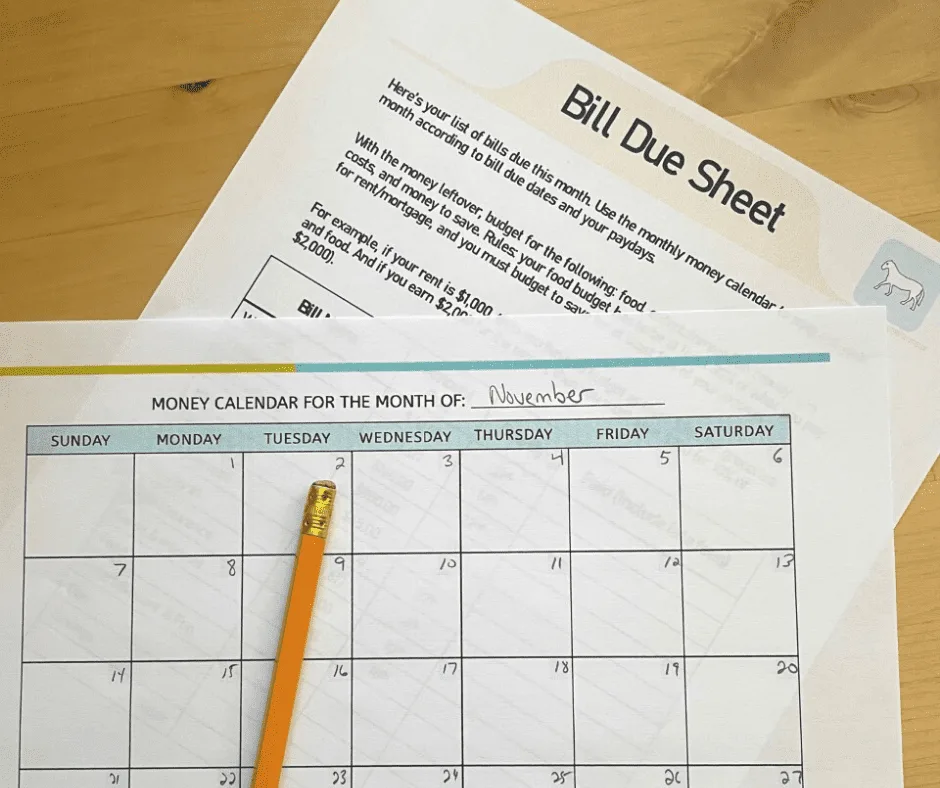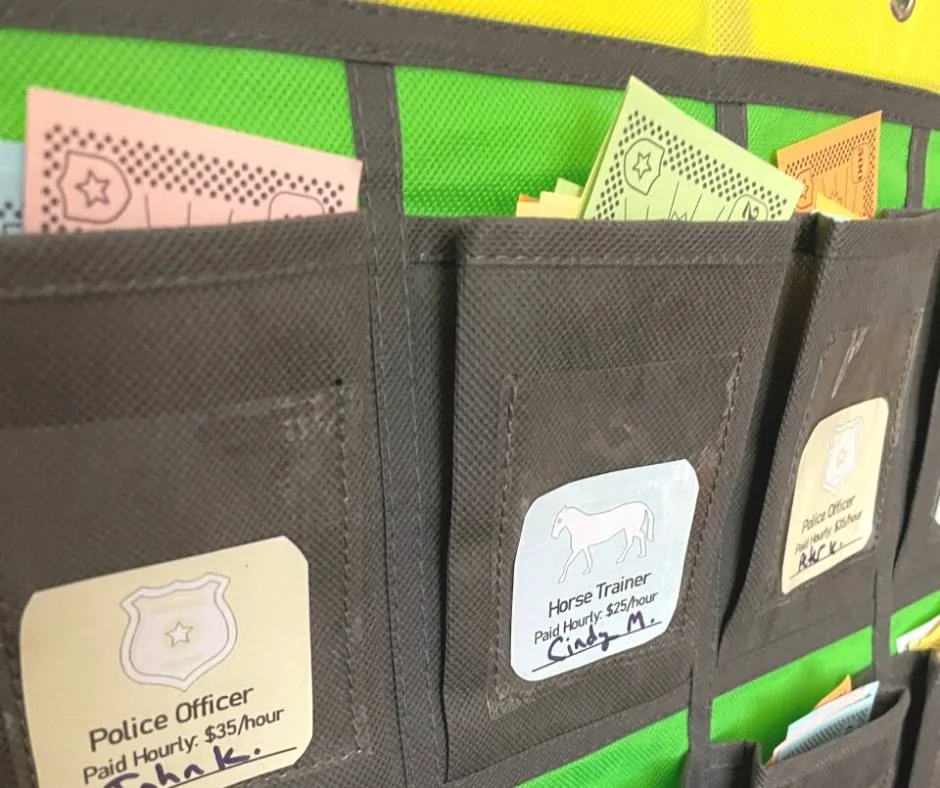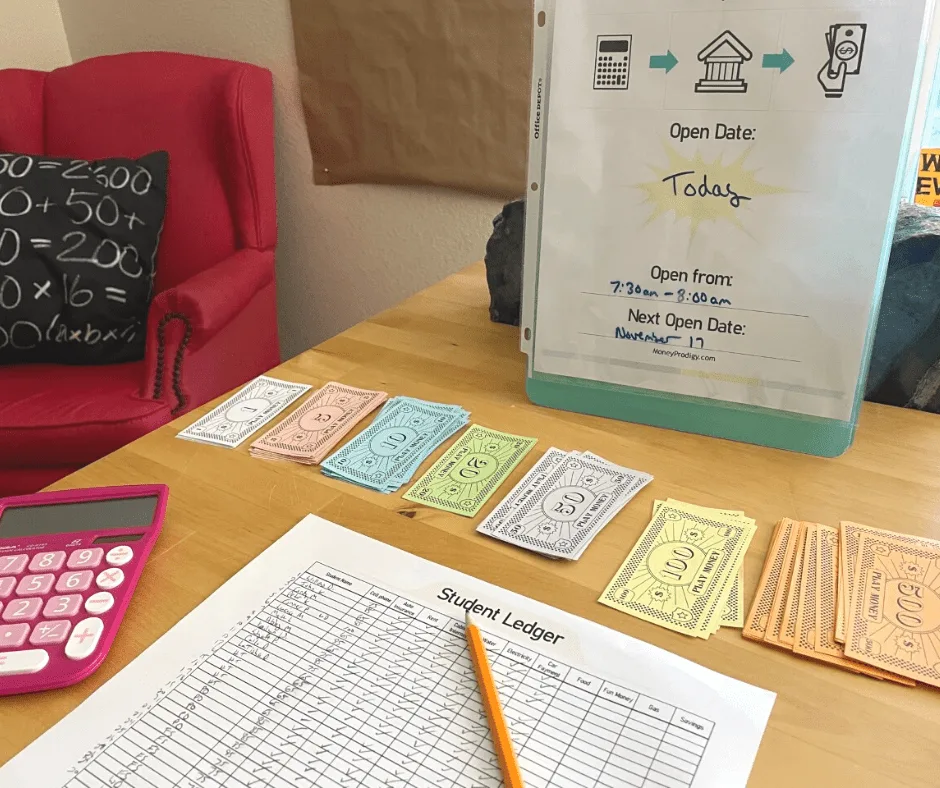
Need a project-based way to teach your teens about managing a limited set of money?

These budget projects for high school students will help them to self-discover some pretty important money lessons, such as:
And I’m starting the list off with my favorite budget project!
We’re going to start off these budget projects with my very new one, a bill-paying budget project scenario.
Stick around for the other three, too!
Hint: you'll also want to check out my article on how to teach budgeting, from beginner to advanced levels.
Bill-paying is not something we’re born knowing how to do.
And it can feel like a slap in the face when you hit the real world and suddenly must be able to:
Most teenagers never deal with a monthly bill due date until they hit the real world – and at that point, slipping up can mean late fees, services turned off, lower credit scores, etc.
Why not give them a heads-up by working on a bill-paying budget project ahead of time?
Here’s a 30-day budget project, including a printable pack I created and am giving away for free for now (yes, I have plans on charging for this in the future – so go ahead and grab a copy!).
At the beginning of the month, assign your high school students one of four jobs. Based on the job they get, they’ll be assigned a list of bills with due dates, and a blank monthly money calendar.

Let your students know they’ll be paying bills over the course of the next month, according to when they are due. Also, tell the students there will be two paydays for the month, and that they’ll be paid pretend money on these days (here is free printable money for kids).
They’ll take their bills sheet, and correctly fill in their monthly money calendar with each of the due dates, plus their paydays. They are then responsible for paying each of these bills by the due date (or face a late fee).
You can choose how to keep track of everything, but I would recommend a bill pay pocket chart.
Here’s how I set mine up to test everything out:

These two items were enough for a class of 30 students:
You’ll need an area of the classroom to collect their money and to sign off on their bill-paying sheet to show they’ve paid.
The person in charge of this can be a teacher, teacher’s aide, or student treasurer (you can switch out each week who fulfills this role).
Choose what schedule the bill-paying station will be open, and use the printable bill-pay chart to communicate times/dates.

Students are now in charge of paying their bills, as they become due (or ahead of time). The treasurer/banker is in charge of keeping the bill-paying station running, as well as filling in the one-sheet student ledger for when each person pays and how much they end up paying.
And someone else (perhaps the teacher) is in charge of paying the students on each of the two paydays.
At the end of the month, there is a set of reflection questions for students to fill out.
To increase the “budgeting” part of this, you could come up with things that pretend money can buy.
This would mean that the students need to prioritize their money and make sure they have enough of it left to pay for each bill by its deadline.
For tight budgets, you can use privileges.
Could make things more interesting!
Have you checked out my article on sample budgets for an 18-year-old?
One of the things I stress is a teen should create a budget for more than one scenario for their next step in life since an older teen’s life opportunities can change so quickly.
You can take your own high school students through this, as a project.
Choose a teen budget worksheet for your students (you can get mine, for free, below), and print out three copies each.
Get your students to help you brainstorm some common (and not-so-common) next steps that can happen in a teen’s life.
Either pick three scenarios from the brainstormed list that every student in your entire class will work on, or let your students pick three different scenarios they’re thinking about living out after they graduate.
Hint: one of the scenarios can be to create a teen budget for their life right now. Then, they can choose their ideal scenario to budget around, and finally, their backup plan scenario to budget around.
Help your students to first brainstorm the budget line items for each scenario.
For example, for a first-apartment scenario, they would want to include:
Ultimately, you want your teen students to see how much they’ll need to earn in order to survive on each of three different scenarios.
You’ll then want to guide discussion on the pros and cons, from a financial perspective to each of the three different paths post-high school.
Decide to throw an end-of-year party for your class, and let them not only handle most of the logistics but also handle the budgeting for it.
You’ll need to have a budget for this, which can be gained from fundraising, donations, etc.
Have each student in the class be in charge of something, perhaps broken up into groups. Then, have the entire class be in charge of the big budget decisions.
Budget decisions to be made:
There are also some great budgeting decisions that need to be made at the group level.
Group budget decisions to be made:
Did you know I have a free, fun budget activity PDF for high school students?
Students use a fun fortune teller to be assigned one of 4 avatars, with a backstory that includes:
They’re asked to fill in a budget worksheet based on their brief. Then, they’re thrown a few budgeting scenarios where they need to think on their feet (based on the budget info they filled out) about how to handle it.
I hope I’ve shown you some budget projects high school students can really get behind because they’re at least a bit fun, they teach real-life information, and they’ll make them think. I’d love to hear from you as far as how it goes!
Amanda L. Grossman is a writer and Certified Financial Education Instructor (CFEI®), a 2017 Plutus Foundation Grant Recipient, and founder of Money Prodigy. Her money work has been featured on Experian, GoBankingRates, PT Money, CA.gov, Rockstar Finance, the Houston Chronicle, and Colonial Life. Amanda is the founder and CEO of Frugal Confessions, LLC. Read more here or on LinkedIn.